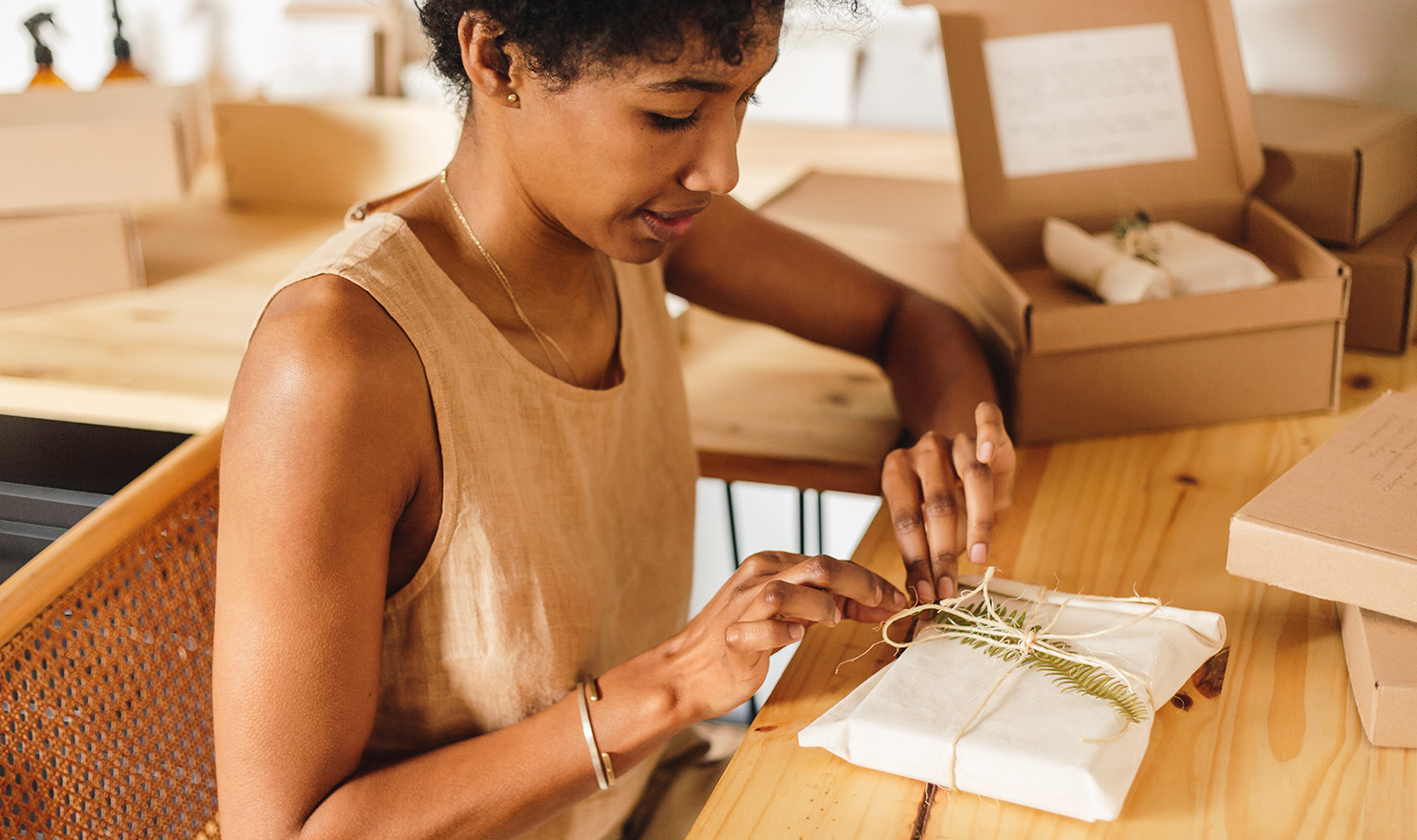So, what exactly is wholesaling? It’s the process of selling your handmade products in bulk to retailers who will then sell them to their customers. It’s a fantastic way to reach a wider audience and increase your sales potential.
Whether you’re a painter, jewelry maker, or any other type of artisan, wholesaling can be a game-changer for your business. Getting started is usually one of the hardest parts of the wholesale process, but we’re here today to help guide you through it all.
Protect Your Products
13 Tips To Start Selling Wholesale
Wholesaling is a customizable and unique operation, so what works for one person may not always work for another. Remember to just have fun with it and make it your own process!
1. Define your target market: Determine the type of retail stores that align with your handmade goods. Consider factors such as the products they sell, their customer base, and their values and aesthetic.
You want to be sure that you work with stores who align with your products and customer base. A good way to do this is by learning what stores your customers typically shop at. Chat with the people you might regularly sell to at events to get a better feel for what types of stores you want to try to wholesale with.
2. Identify the best products for wholesale: Not every product of yours might be the best for wholesale — you want to focus on products you can easily reproduce at a reasonable price within a reasonable timeframe. Things like prints of your artwork, jewelry, home decor, screen printed shirts, mugs, and stickers are great pieces to start with.
As you get some more experience and form relationships with retailers, you can start moving on to larger items. Just give yourself some time to try out wholesaling first before you go all-in with your top-dollar items.

3. Establish your pricing structure: Product pricing is often a nightmare for anyone, even more so when you’re trying to factor in wholesale pricing. You’ll want to calculate your production costs, including materials, labor, and overhead expenses. Set wholesale prices that allow for a profit margin while remaining competitive in the market.
The easiest way to do this is to make your wholesale prices half of your retail prices. You can also use this easy formula from Goodtype to come up with your price structure:
Cost of goods = Cost the produce one item
Cost of goods x 2 = Wholesale price
Wholesale price x 2 = Retail price
4. Create a wholesale catalog: Do you remember the product catalogs that would often come in the mail? They often looked like a printed version of a QVC episode. That’s what you want to try to replicate, just geared more toward your brand and style.
A wholesale catalog is typically a digital document that showcases your products available for wholesale. You’ll want to include:
- Pictures
- The wholesale price
- A product number (SKU)
- A minimum order quantity
A minimum order quantity is usually you saying someone needs to order at least a certain number of your product, and their order needs to be a minimum of a certain amount. Doing so will make sure you are still pulling in a profit and not just selling one item for a heavily discounted price. Most wholesalers set their minimum price around $150.
Other sellers will include a product description, the suggested retail price (SRP), and purchasing instructions in their catalog.

5. Establish an inventory management system: Now, where will your catalog and purchasing process live? This is entirely up to you! Some wholesalers will use physical catalogs and line sheets they deliver to retailers. Others will use an online third-party platform, or create a separate page on their website for wholesale orders.
Some of the top online platforms for wholesaling are:
We recommend just starting out on one site. As you grow your wholesale business, you can expand to other locations.
6. Research and identify potential retailers: For sellers looking to go a more personal route, you can get your foot in the wholesale door by talking to local retailers in your area. Remember the target market research we talked about in our first tip? This is where that comes in handy!
Many creatives have gotten their start in wholesale by striking up a partnership with locally owned businesses. Places like coffee shops, boutiques, and specialty stores are a great place to get your foot in the door.
Ask about their buying processes, product requirements, and contact information. Have your catalog on hand to share with them, and always be sure to follow up later.
Pro-Tip: Other wholesale avenues you can try are with local event venues and event planners. This can be a great way to start selling wholesale for parties, weddings, and events.

7. Reach out to retailers: Local businesses aren’t the only ones to talk to. Larger retailers are always looking for new products to add to their shelves. You can occasionally find this contact information on their website, or by asking in person.
Usually you need to craft a personalized email or letter to introduce yourself and your handmade goods. Make your messages personalized, including photos and your business’s story to form a connection.
Highlight the unique aspects of your products, the benefits of carrying them in their store, and any positive customer feedback or previous wholesale relationships you have had. Attach a copy of your catalog and any line sheets or order forms. Be sure to include your contact information as well.
8. Attend trade shows and craft fairs: Participate in trade shows and craft fairs relevant to the industries you want to break into. This means going beyond a local farmers market or craft show.
Look for expos and trade shows where your target market might be. See if any associations are hosting events you can join.
These events attract retail store owners and buyers who are actively seeking new products. Use this opportunity to showcase your goods, network, and establish connections with potential retailers.
You can even invite local retailers to visit your booth at these events so you can give them the chance to meet you face to face and see your products.

9. Offer samples or product demonstrations: Provide samples or host product demonstrations to allow retailers to experience the quality and appeal of your handmade goods firsthand. This can help generate interest and build confidence in your products.
It can be especially helpful to send a retailer samples of your products so they can get a better idea of your brand and what you sell. If you plan on reaching out to some retailers or visiting local shops, have some samples on hand if possible.
You can also assemble sample boxes and mail them to retailers you want to work with. This will go beyond just sharing a catalog — it gives them the opportunity to physically connect with your brand and see the detail in your work up-close.
10. Negotiate terms and agreements: Once a retailer expresses interest, negotiate the terms of your wholesale agreement. This includes:
- Pricing
- Payment terms
- Minimum order quantities
- Delivery schedules
- Insurance requirements
- Exclusivity arrangements
It’s helpful to have these items already laid out before the negotiation process so you don’t get taken advantage of. Know what your limits are and what you are willing to negotiate on. Be firm, but friendly during this process (which can be hard, I know!). The idea of “under promise and over deliver” applies well here.
Whatever terms you agree on, make sure you get it all in writing so both parties hold up their end of the bargain.

11. Fulfill orders professionally: When you receive wholesale orders, ensure prompt and reliable delivery of your handmade goods. Maintain open communication with retailers and provide excellent customer service to foster long-term partnerships.
If you know what products are more likely to sell faster, make sure you create a large inventory of it first and are regularly making more of this product so you can fill orders more quickly.
The last thing you want is to realize you are short on product and might miss a deadline. Having strict inventory management is key to efficiently fulfilling all of your orders.
12. Pre-package your products: The world of retail is fast-paced, so the easier you can make things for them, the better. Prepackaged products means they only need to add a price tag and get it on the floor to start selling.
You can pre-package your products by wrapping them in cellophane, putting fragile items in boxes, adding stickers or business cards to packages, and making each item look the way you would sell it individually to a customer. You may need to include some samples and display instructions as well.

13. Show your retailers some love: Little actions can go a long way and result in long-term retail relationships. Your retailers are often doing a lot of heavy lifting for you on the advertising front, so it can be helpful to do some in return.
Have a spot on your website dedicated to showing customers what stores your products are featured in, or create a highlight on an Instagram page where you share posts of your products in different retail shops.
If you have a newsletter, you can drop a mention in for any new retailers carrying your products and add a link to their site. It helps you help them, so everyone wins!
Pro-Tip: You may want to offer some perks to retailers who are buying from you for the first time. This could include free shipping costs, a discount on their first order, or a bundle deal when getting multiple items.

Happy Sales!
Remember, building relationships and maintaining a professional image are crucial in the wholesale business. Continuously seek new opportunities, refine your product offerings, and adapt to the changing needs of your retail partners.
Good luck with your wholesale journey!










